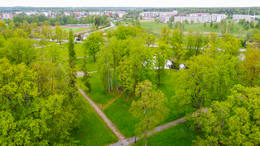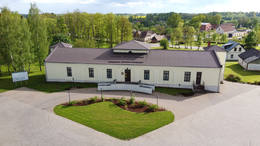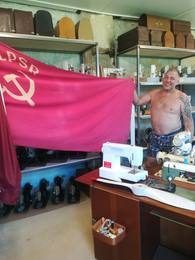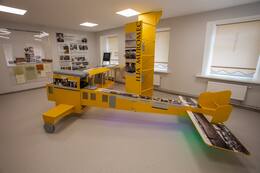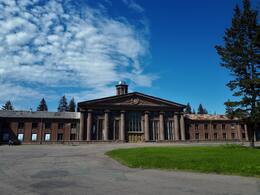Latvian Army Aviation Regiment
I World War I, I Wars of Independence, Independence of the Baltic States, II World War II
Established as the Aviation Group on 7 June 1919, the regiment was known as the Aviation Park from September 1920 and Aviation Division from March 1921 to September 1926.
In 1939, the Aviation Regiment included the regiment’s headquarters in Riga, 8 operational squadrons (60 aircraft, 120 pilots and 80 specialists), a military aviation school, repair shops and a supply warehouse. Airfields and auxiliary airfields were located in Riga (at the Spilve Airport), in Rāmava, Jumpravmuiža (Rumbula Airport), Koknese, Gulbene and Krustpils (Krustpils Airport).
Maritime aviation bases were situated in Liepāja and Usma. After the occupation of Latvia, the Aviation Regiment was disbanded on 25 December 1940.
Related objects
Latvian Military Aviation Airport
Located in the territory of Vecgulbene Manor - in the historical center.
In the interwar period, Gulbene was home to a Latvian army garrison, where the 7th Sigulda Infantry Regiment battalion was stationed. In the mid-1930s, the creation of a military aviation base began, because for the successful operation of military aviation, an extensive network of airfields must be ensured even in peacetime. Airfields are especially important in places where important railway and road junctions have been established. On November 11, 1935, construction of a military airfield began here. In 1937, a newly formed Aviation Regiment unit was stationed in Gulbene, which became the 6th reconnaissance squadron of the Latgale Division, increasing the number of army units near the eastern border of Latvia.
The Orangery building is visible.
Gulbene County History and Art Museum
Located near the Vecgulbene Manor, on Litenes Street.
In the second half of the 1940s, the Soviet Army Unit No. 75568 radar company was stationed in the Vecgulbene Manor orangery and the adjacent manor gardener's house. For its needs, locator mounds were built and locators were installed at the airfield (former Latvian military aviation airfield). At the end of the 1980s, they were moved to Beļava parish. The Soviet army left Gulbene in 1993.
A square is visible, with two artificially raised mounds on Litenes Street.
Private collection of military objects and sewing machines
The only sewing machine collection in Latvia with more than 200 different sewing machines from the pre-war and Soviet periods, which played a direct role in the production of military clothing in the pre-war and war years. Collection creator - Juris Beloivans
“Jāzeps Baško – Gaisa Fūrmanis” (“Jāzeps Baško – Air Cabman”) Exhibition of Preiļi Museum of History and Applied Arts
The “Jāzeps Baško – Gaisa Fūrmanis” (“Jāzeps Baško – Air Cab man”) exhibition is dedicated to the 125th birthday of General Jāzeps Baško, the commander of the “Iļja Muromec” squadron and the organiser of the Latvian Air Force, and to the 100th anniversary of World War I.
The exhibition of the museum collection resembles a design object – a model of the Ilya Muromets aircraft that has been reduced in size 6 times, with information in the form of texts and images provided on the model. The exhibition is enriched by exhibits from the collections of the Latvian War Museum and newly acquired information from the Latvian State Historical Archive, the Spilve Aviation Museum and private archives of individuals. Jāzeps Baško is rightly one of the most awarded Latvians and pioneers of global aviation. He set 4 global aviation records flying Ilya Muromets aircraft. His name is inscribed in the Louis Blériot Golden Book in Paris, i.e., the Golden Book of the world’s best aviators. Jāzeps Baško was awarded all orders of the Russian Empire of his time, in Latvia – the Order of the Three Stars, 3rd Class, the Order of Viesturs, 2nd Class, the Home Guard Cross of Merit, as well as the highest awards of Czechoslovakia, Estonia, Finland, and Poland.
He served in the army of the Russian Empire, the Bolshevik Red Army, and, in 1921, he joined the Latvian Army. He retired from service after the occupation of Latvia.
Vaiņode air base
Vaiņode airfield still has 16 Soviet-era aircraft hangars and an 1800 m section of the once 2500 m long runway. The airfield can only be visited with a previous booking. Vaiņode airfield was established during the Latvian independence as one of the cradles of Latvian aviation and was later one of the largest military airfields in the Baltic States. In 1916, two hangars for German Army airships were built. Airships were used to gather intelligence and bomb the positions of the Russian Army. Later the city of Riga bought the airship hangars and used their roof structures to build the pavilions of the Riga Central Market. In May 1940, the 31st Fast Bomber Aviation Regiment of the Red Army moved to Vaiņode, and the construction of a standardized concrete slab runway began. At the end of the summer of 1944 the partially completed airfield was used by various German aviation units, however, at the end of World War II, the same airfield was used by the Red Army aviation units fighting the German Army group called ‘Kurzeme’. After World War II the Soviet Air Forces were stationed in Vaiņode until 1992.
Spilve airport
Located in Riga, Pārdaugava, in the Spilve meadows near Iļģuciems.
Spilve is famous in the history of military heritage for the grandiose Battle of Spilve in the 18th century and the Spilve airfield. Starting in the 20th century, it was used for testing aircraft, but during World War I it became a witness to the history of Latvian aviation.
During World War I, the Spilve meadows were used by the Russian army's air force for the purposes of fighting the German army. With the creation of Latvia, the airfield became the country's most important air force base and a training ground for pilots. The airfield's previous names were "Spilves Air Port" or "Riga Air Port", later "Riga Central Airport". It was the main airport in Latvia until the opening of the airport "Riga" in 1975.
Perhaps the Spilve airfield near Riga and the dream of reaching for the stars have contributed to the impressive achievements of many Latvian pilots. Perhaps, however, the beginning of Latvian aviation is much older and can be found in Priekule, where a Latvian blacksmith Zviedris made a flight from a church tower with a homemade device.
Today, the Spilve airfield is still in operation. You can see the airport building, built in 1954, which embodies the Soviet classicism or “Stalin Empire” style.
Sources:
Irbītis, K. Latvian aviation and its pioneers. Riga: Zinātne, 2004.
Brūvelis, E. History of Latvian Aviation: 1919-1940. Riga: Zinātne, 2003.
Official website of the state agency "Civil Aviation Agency". Available: https://www.caa.gov.lv/lv/latvijas-aviacijas-vesture-isuma [accessed 22.02.2021].
Keruspils (Jekabpils) Airport
Krustpils airfield was located near Veselmuiža. A small airfield was already there during the First World War. Its borders were slightly expanded during the Free State of Latvia. The 7th Squadron of long-range reconnaissance was stationed here. One of the commanders was Captain Ēriks Mellups. Around 1935, a new reinforced concrete hangar and two-story barracks were built. At the beginning of the war, the airfield housed aircraft that had been moved from other places and destroyed by German aviation.
During the years of Soviet occupation, the borders of the airfield were significantly expanded. In February 1941, 282 ha of land with surrounding houses were handed over to the Red Army. In April 1941, almost 700 ha were requisitioned. In this way, 152 buildings of surrounding farms were destroyed. Residents of the surrounding parishes within a 50 km zone were involved in the construction work.
In 1974, due to the expansion of the take-off and landing strip, the airfield was expanded by another 44 ha.
Today, Jēkabpils Airfield is an abandoned military airfield, partially privatized with a partially preserved runway and buildings.
Related stories
United Aviation Day - a true national holiday
The narrator describes one of Latvia's most popular and widely attended events – the Aviation Festival in Spilve. He describes the course and scope of the festival. He emphasizes the popularity of aviation in Latvia.
Bombing of Rezekne in 1944
The bombing of Rēzekne took place on Easter 1944, and as a result, a large part of the city's buildings were destroyed and dozens of civilians were killed, while thousands more were left homeless. The people who experienced these events firsthand and can tell us about them were only children at the time. The author of this story is one of them.









